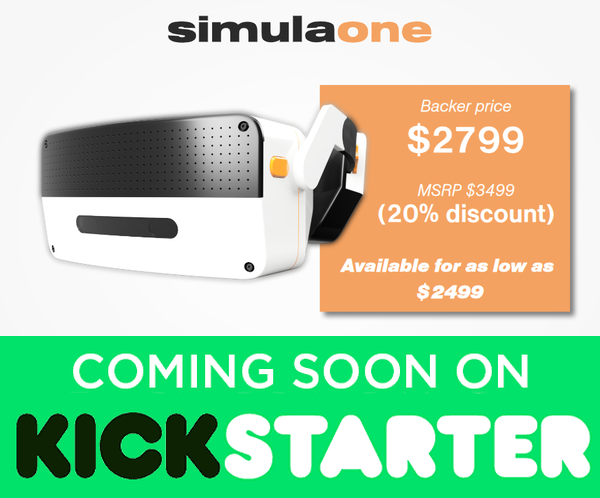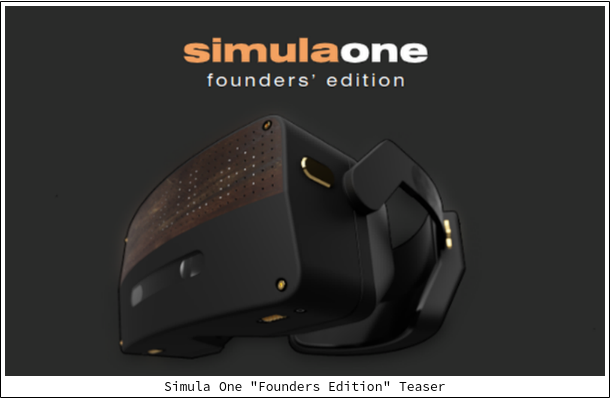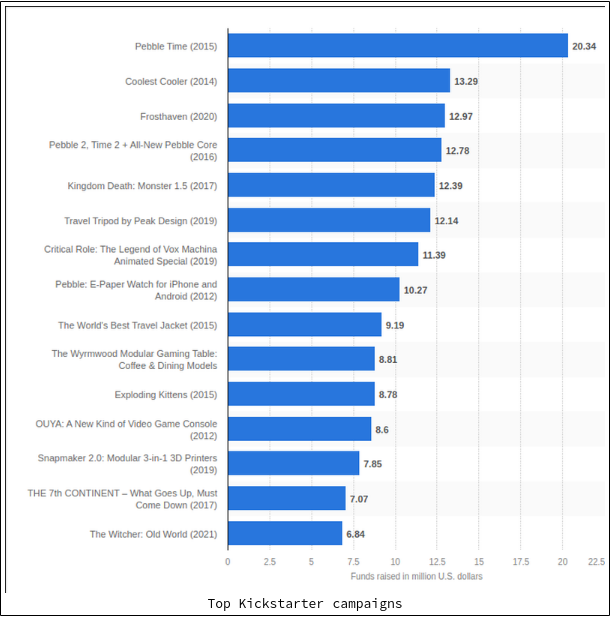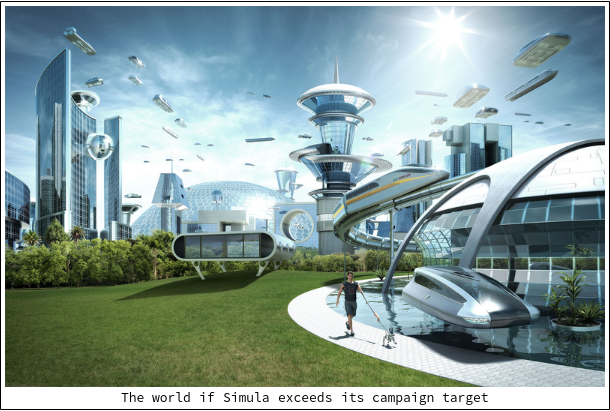
1 Pricing
The Simula One will be priced at $2,799 for Kickstarter customers ($3,500 MSRP after the campaign finishes). A very limited number of headsets will be priced at $2,499. For a review of Simula One's specs, check out our VR comparison post. If you're reasonably sure you want to purchase a headset, and you'd like to be notified an hour before the campaign starts (to maximize chances of getting this discount), add your email to our new "Early Kickstarter Backers" list:
In order to proceed with headset manufacturing, we must raise $2.5M, which represents our breakeven costs. In order to help reach our target, we will have additional options and accessories available for our Kickstarter customers, including: (i) Tethered-only headsets for gamers/customers who want to provide their own compute, (ii) docking stations for office desks, (iii) a more expensive headset made with finer materials (for the aesthetically inclined), and of course (iv) SimulaVR tux plushies :D We also have some special bonuses planned if we exceed certain raise thresholds.

2 Breakeven unit cost model
This section details how we derived our headset price and campaign target. The costs associated with building the Simula One can be divided into 3 categories:
- Variable costs (components). Principle components include raw materials, displays, lenses, NUC compute units, carrier boards, batteries, and cameras. Also included are things like fasteners, screws, and springs.
- Fixed costs (annually recurring). Includes salaries for our existing 3-person team, assembly labor, and money to hire additional mechanical, electrical, and software engineers. Also includes a small allocation towards legal and accounting expenses.
- NRE costs (capital expenditures). Includes CNC, injection mold tools, assembly line setup (fixtures, applicators, fastening tools, etc), and lens tooling. A few of our suppliers also pass on a small amount of their own NRE to us. Also includes an allocation for regulatory compliance/testing.
Due to NDAs with our suppliers, we are unable to show a detailed pricing model. We have however prepared a coarser model which shows the inverse relationship between the units we sell and our unit costs. The bolded column represents our target breakeven case: selling 892 headsets @ $2,799/unit, costing us roughly $2.5M (our Kickstarter target).
| Units Sold: | 100 | 300 | 500 | 892 |
|---|---|---|---|---|
| Variable Costs (Components) | $5,217.61 | $2,524.50 | $1,985.90 | $1,630.85 |
| Fixed Costs (Annually Recurring) | $5,540.00 | $1,846.67 | $1,108.00 | $621.08 |
| NRE Costs (Capital Expenditures) | $3,048.00 | $1,016.00 | $609.60 | $341.70 |
| Kickstarter + Payment Processing Fees (8%) | $1,104.45 | $430.97 | $296.28 | $207.49 |
| Total Unit Cost | $14,910.06 | $5,818.15 | $3,999.78 | $2,801.12 |
| Total Costs (aka Kickstarter Target) | $1,491,006.38 | $1,745,443.58 | $1,999,889.42 | $2,498,603.26 |
| Profit @ $2,799K/unit | $(1,211,006.38) | $(905,443.58) | $(599,889.42) | $(1,003.26) |
3 Chance of failure
As far as we know, there's no one else in the market working on a portable Linux VR Computer. So we think it's worth the risk of failure to try to fund ours. With that said, a $2.5M target is an ambitious minimum for a Kickstarter campaign offering a "niche toy product" like the Simula One. In fact it is a mere mere two doublings away from an all-time raise:

We've noticed that other campaigns will sometimes target very small fundraising goals in order to easily beat them/not risk public failure. That is not the case with our campaign: it takes a higher amount of money to jumpstart an operation like this, and we'd rather be open & transparent with people about it up front.
TLDR: There is a very real chance our Kickstarter campaign could fail, forcing us to either abandon the project or to delay operations in order to figure out another way to fund it.
4 But what happens if we raise more than our target?

It's still enticing to think about scenarios where we exceed our Kickstarter target, allowing us to offer more value to early backers and the VR computing community.
- Bonus features. We will have more information about this in our Kickstarter campaign, but expect bonus features like halo straps and front-panel LED matrix displays for all shipped VRCs if we exceed certain thresholds.
- Software improvements. More money means we can hire more developers to help improve our VR window compositor, helping all future owners of Simula headsets. Some potential things on the horizon for us: window tiling/grouping, curved windows, environments, rendering optimizations, and VR Compiz effects.
- Risk reduction. Extra funds allow us more leverage to solve our own problems, when e.g. running into third party delays or frictions that might otherwise arise during mass production.
- Second headset R&D. Enough funds raised could allow us some bandwidth after the project is finished to start R&D'ing our next (potentially AR) headset iteration.
5 How to help us out
If you're reasonably sure you want to purchase a headset, and you'd like to be notified an hour before the campaign starts (to maximize chances of getting early discounts), add your email to our new "Early Kickstarter Backers" list:
If you'd like to support us in other ways:
- Share. Follow us on Twitter and share our campaign to your followers!
- Discuss. If you have questions about our headset, you can check out /r/simulavr and our Discord.
- Join. If you're interested in joining our team, send resumes over to info@simulavr.com. We will start hiring for positions in February, and are looking for talented electrical, mechanical, and software engineers.
